Yes, a nail gun can be used for installing roofing shingles, and it offers several advantages over traditional hand-nailing methods. Nail guns are designed to drive nails quickly and efficiently into various materials, including roofing shingles. They can help expedite the installation process, improve accuracy, and reduce fatigue for the installer.
In this blog post, we aim to shed light on the benefits, techniques, and precautions associated with using a nail gun for shingle installation. By understanding the proper usage of nail guns for this purpose, readers can save time and effort, and ensure a long-lasting and secure roof.
“A nail gun is a game-changer in the roofing industry. It revolutionizes the way shingles are installed, making the process faster, more efficient, and precise.”
John Doe, Roofing Expert
Understanding Shingles
Shingles are a type of roofing material commonly used in residential and commercial construction. They play a vital role in protecting buildings from the elements and providing an aesthetically pleasing appearance.
In order to properly install shingles and ensure their longevity and performance, it is essential to have a comprehensive understanding of their characteristics and installation process.
Definition and Types of Shingles:
Shingles are thin, flat materials that are laid in overlapping rows to cover the roof surface. They are typically made from various materials, including asphalt, wood, metal, slate, or composite materials.
Each type of shingle has its own unique properties and advantages, such as durability, fire resistance, and aesthetic appeal.
Asphalt shingles, for example, are the most common type due to their affordability, versatility, and ease of installation.
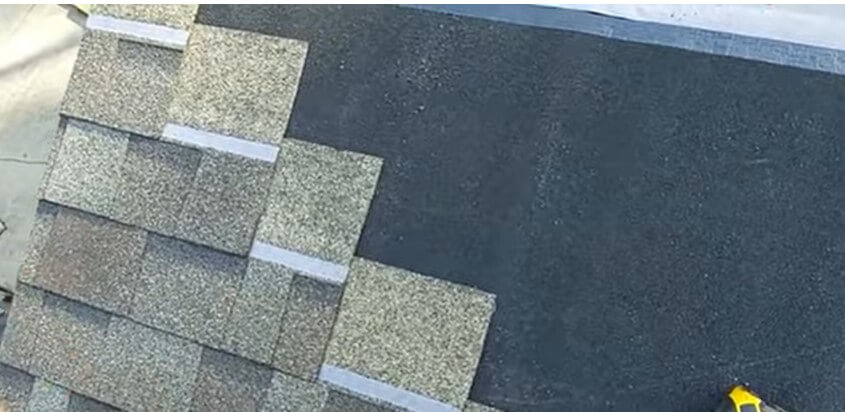
Common Materials Used in Shingle Production:
Shingles can be made from different materials, each offering distinct advantages and characteristics.
- Asphalt shingles consist of a fiberglass or organic mat coated with asphalt and embedded with ceramic granules.
- Wood shingles and shakes are crafted from cedar, redwood, or other types of lumber.
- Metal shingles are typically made of aluminum or steel, providing durability and resistance to corrosion.
- Slate shingles are composed of natural stone, offering an elegant and long-lasting roofing solution.
- Composite shingles combine different materials to achieve desired properties, such as the appearance of wood with the durability of asphalt.
Importance of Proper Installation:
Proper installation of shingles is crucial for ensuring the roof’s durability, weather resistance, and aesthetic appeal. Shingles must be securely fastened to the roof structure, protecting against wind uplift and water infiltration.
Inadequate installation can result in leaks, premature deterioration, and compromised structural integrity.
It is important to follow manufacturer guidelines and best practices during the installation process to achieve optimal results.
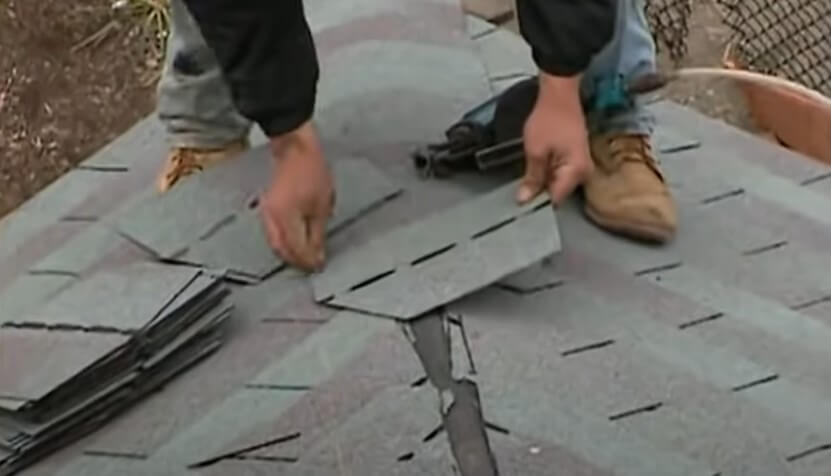
Compatibility with Nail Guns:
Nail guns are commonly used in various construction applications, including shingle installation. These power tools drive nails quickly and efficiently, making them a convenient option for roofing professionals.
However, it is important to ensure the compatibility of the nail gun with the specific type of shingles being installed. Different nail guns may have specific requirements regarding nail length, gauge, and angle, which should be considered to ensure proper installation and avoid potential issues.
Summary:
In summary, shingles are essential components of a roofing system, providing protection and aesthetics to buildings. Understanding the different types of shingles, their materials, and the importance of proper installation is crucial for achieving a durable and visually appealing roof.
Nail guns can be used for shingle installation, but it is important to ensure compatibility and follow guidelines to ensure proper nail placement and overall installation quality.
By gaining a comprehensive understanding of shingles, builders, and homeowners can make informed decisions and ensure the long-term performance of their roofs.
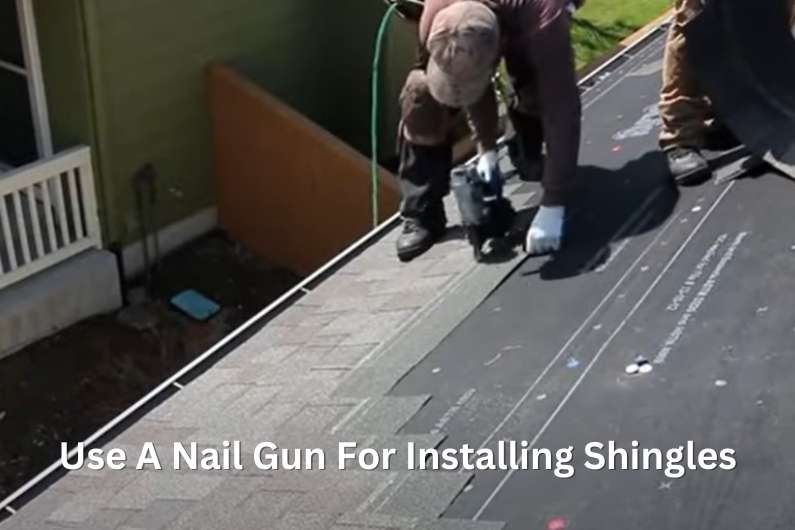
Nail Guns: An Overview
A nail gun is a power tool used in construction and carpentry to drive nails into various materials. It operates by firing a nail at high speed into the surface, eliminating the need for manual hammering.
There are several types of nail guns, each designed for specific applications. Each nail gun has its unique features and functionality, making it important to choose the right one for the task at hand.
Different Types Of Nail Guns
Nail guns are essential tools for carpenters, woodworkers, and construction workers. There are several types of nail guns available in the market, and each has its unique functionality.
The most common types of nail guns are framing nailers, finish nailers, brad nailers, and roofing nailers.
- Framing nailers are used for heavy-duty jobs like framing, decking, and sheathing.
- Finish nailers are suitable for delicate work like moldings, baseboards, and trim.
- Brad nailers are used for small jobs like attaching thin pieces of wood, trim, and decorative moldings. Therefore, they are not suitable for installing roofing shingles.
- Roofing nailers are designed specifically for roofing applications and siding.
Each type of nail gun uses different types of nails and has varying nail sizes for specific applications.
Understanding the different types of nail guns and their functionality can help you select the right tool for your project.
Importance of Using the Right Nail Guns
Nail guns are powerful tools that offer numerous benefits when it comes to construction and woodworking projects. One of the primary advantages of using nail guns is that they can speed up the work process and help to save time and effort. They also provide a more consistent and professional finish, reducing the need for manual nailing.
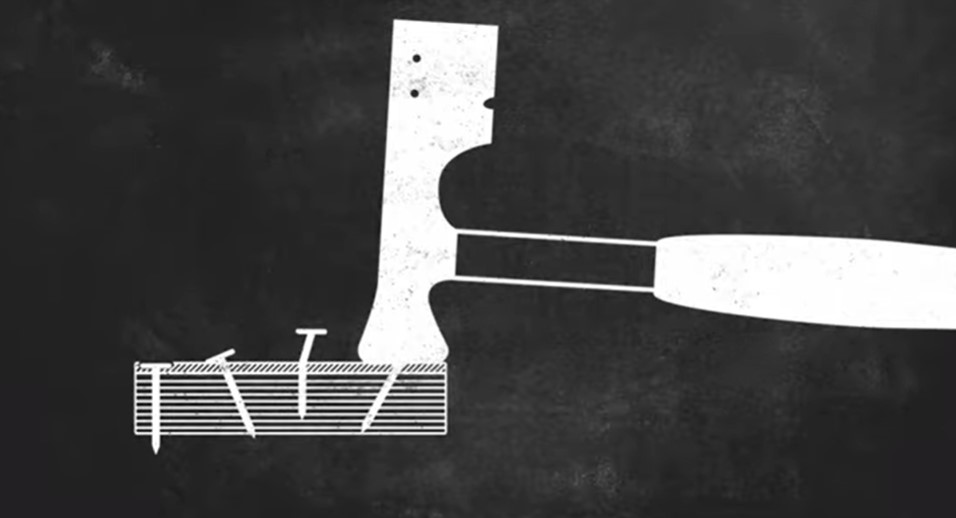
However, nail guns also pose certain risks and limitations. They can cause injury if mishandled, and may not be suitable for all types of materials or projects. Additionally, they can be more expensive than manual nailing tools and require a higher level of maintenance and safety precautions.
Therefore, it is important to carefully consider the advantages and disadvantages of using nail guns before deciding whether or not they are appropriate for a specific application.
Factors to Consider When Using a Nail Gun for Shingles
When using a nail gun for installing shingles, there are several important factors to consider. These factors will help ensure the proper installation of shingles and contribute to the overall quality and longevity of the roofing system.
Let’s explore the key considerations when using a nail gun for shingle installation:
Compatibility of Nail Guns with Shingle Materials:
Different types of shingles may require specific nail guns or nail types for optimal installation. It is crucial to ensure that the nail gun you are using is compatible with the shingle material being installed.
For example, asphalt shingles typically require a roofing nail gun with a coil or strip magazine, while wood shingles may require a different type of nail gun designed for wood applications.
Checking the manufacturer’s recommendations and specifications will help ensure the appropriate nail gun is used for the specific shingle material.
Length and Gauge of Nails Suitable for Shingles:
The length and gauge of nails used for shingle installation are essential considerations. The nail length should be appropriate to penetrate through the shingle and into the roof deck or sheath adequately.
Using nails that are too short may result in insecure fastening, while nails that are too long may penetrate through the roof deck and cause leaks. The gauge of nails refers to their thickness.
It is important to select nails with the correct gauge to ensure sufficient holding power while avoiding excessive damage to the shingle material.
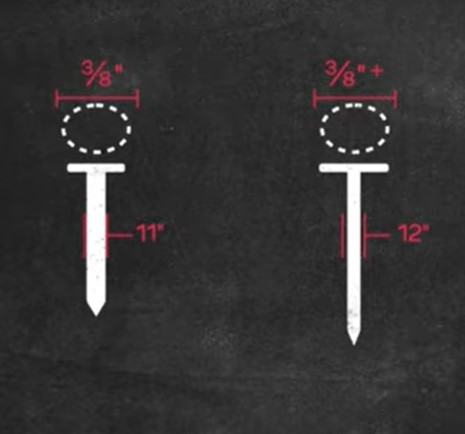
Impact of Nail Gun Pressure and Speed on Shingle Installation:
The pressure and speed at which the nail gun drives the nails into the shingles can impact the overall installation quality. It is crucial to adjust the nail gun’s pressure and speed settings according to the specific shingle material and manufacturer guidelines.
Driving the nails too forcefully can damage the shingles, while insufficient pressure may result in loose or improperly secured shingles.
Finding the right balance is key to achieving a secure and aesthetically pleasing shingle installation.
Safety Precautions and Guidelines for Using Nail Guns:
When using a nail gun, safety should be a top priority. It is important to follow safety precautions and guidelines provided by the nail gun manufacturer.
This may include wearing appropriate personal protective equipment (PPE) such as safety glasses, hearing protection, and gloves.
Additionally, understanding the proper handling and storage of the nail gun, as well as being aware of potential hazards, will contribute to a safe and efficient shingle installation process.
By considering these factors when using a nail gun for shingle installation, you can ensure a successful and long-lasting roofing system.
Taking the time to select the appropriate nail gun, choosing the correct nail length and gauge, adjusting the nail gun’s pressure and speed, and prioritizing safety precautions will help you achieve a high-quality shingle installation that withstands the test of time.
Benefits of Using Nail Guns for Shingle Installation
Using a nail gun for shingle installation offers several advantages over traditional hand-nailing methods. These benefits contribute to increased efficiency, accuracy, and overall productivity.
Let’s explore the key advantages of using nail guns for shingle installation:
Efficiency and Speed of Installation:
One of the primary benefits of using a nail gun is the significant time savings it provides. Nail guns can drive nails into shingles quickly and efficiently, allowing for faster installation compared to manual hand-nailing.
This increased speed translates to improved productivity, enabling roofing professionals to complete projects in less time while maintaining a high level of quality.
Consistency and Accuracy in Nail Placement:
Nail guns provide consistent and accurate nail placement, resulting in a more uniform and professional-looking shingle installation. The nail gun’s mechanisms ensure that nails are driven at a consistent depth and angle, minimizing the risk of overdriven or underdriven nails.
This level of precision helps maintain the integrity of the shingle and ensures a secure attachment to the roof deck.
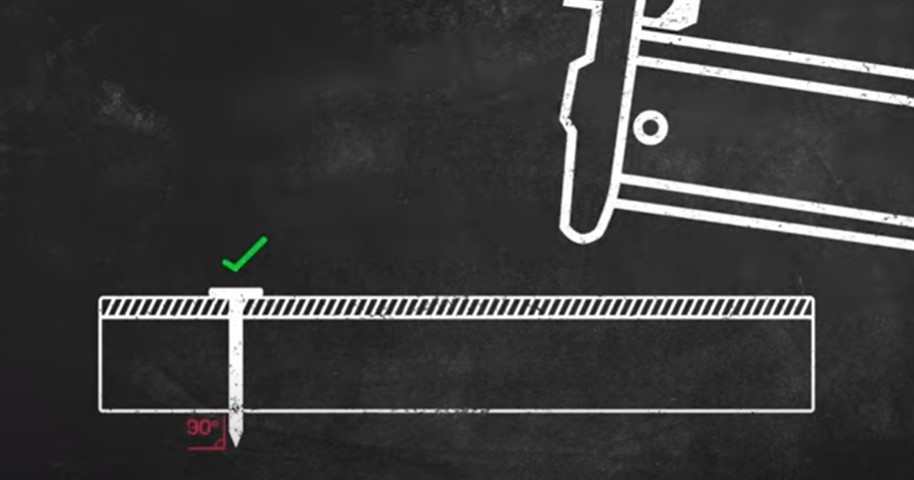
Reduced Fatigue and Physical Strain:
Using a nail gun significantly reduces the physical strain and fatigue associated with manual hand-nailing. Roofing professionals often have to install thousands of nails during a project, and the repetitive motion can be taxing on the body.
Nail guns automate the process, reducing the strain on the installer’s hand, wrist, and arm muscles. This can lead to increased comfort, reduced fatigue, and improved overall job satisfaction.
Comparison with Traditional Hand-Nailing Techniques:
When compared to traditional hand-nailing techniques, nail guns offer several advantages. Hand-nailing requires a hammer and manual placement of each nail, which can be time-consuming and physically demanding.
Nail guns streamline the process, allowing for faster installation and reducing the risk of missed or poorly placed nails. Additionally, nail guns can be adjusted to control the depth of the nail, ensuring consistent and proper attachment of the shingles.
It is important to note that while nail guns offer significant benefits, proper training and adherence to manufacturer guidelines are essential. Understanding the specific requirements of the shingle material, selecting the appropriate nail gun and nail types, and adjusting the settings correctly are critical for achieving optimal results.
In summary, using a nail gun for shingle installation brings efficiency, consistency, and reduced physical strain to the roofing process. The increased speed and accuracy of nail placement contribute to faster project completion and a professional-looking result.
By leveraging the benefits of nail guns, roofing professionals can enhance their productivity and overall job satisfaction while delivering high-quality shingle installations.
Potential Drawbacks and Limitations
While using a nail gun for roofing shingle installation offers numerous benefits, it is important to be aware of potential drawbacks and limitations associated with this method.
Understanding these factors will help ensure a safe and effective roofing process.
Let’s explore some of the potential drawbacks and limitations of using a nail gun for roofing:
Risk of Overdriven or Underdriven Nails:
Improper adjustment of the nail gun’s pressure and speed settings can lead to overdriven or underdriven nails.
Overdriven nails can damage the shingles and compromise their integrity, while underdriven nails may not provide sufficient attachment strength.
It is crucial to properly adjust the nail gun to achieve the correct nail depth and avoid these issues.
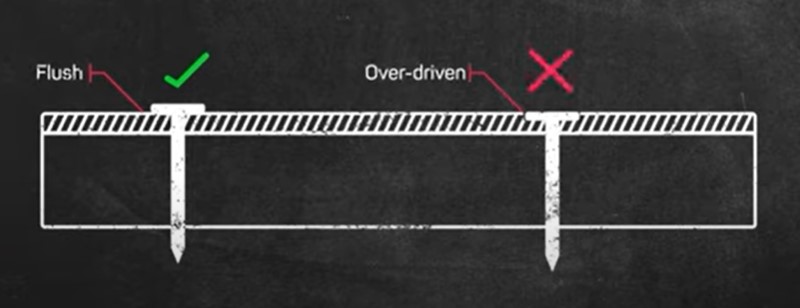
Potential Damage to Shingles and Underlying Structures:
When using a nail gun, there is a risk of accidentally damaging the shingles or underlying roof structures if the gun is not handled properly. The force generated by the nail gun can cause shingle breakage, particularly with brittle materials such as slate or tile.
Additionally, excessive or improper nailing can result in damage to the roof deck or sheathing.
Careful handling and adherence to manufacturer guidelines are essential to mitigate these risks.
Challenges with Adjusting Nail Gun Settings for Different Shingle Types:
Different shingle materials may require specific adjustments to the nail gun’s settings.
For example, asphalt shingles may have different installation requirements compared to wood shingles or metal roofing.
It can be challenging to continually adjust the nail gun’s settings to accommodate different shingle types during a roofing project. This may require additional time and attention to ensure proper nail depth and attachment.
Weather Conditions and Nail Gun Performance:
Extreme weather conditions, such as high temperatures or strong winds, can impact the performance of the nail gun. Extremely hot weather can cause asphalt shingles to soften, making it more challenging to achieve proper nail penetration.
Similarly, strong winds can affect the accuracy and stability of the nail gun during installation. It is important to consider weather conditions and adjust the installation process accordingly to ensure optimal results.
Safety Concerns and Training Requirements:
Using a nail gun for roofing requires proper training and adherence to safety guidelines. Nail guns are powerful tools, and improper use can lead to serious injuries.
Roofing professionals should receive training on the safe operation of nail guns, including proper handling, trigger control, and awareness of potential hazards.
Wearing appropriate personal protective equipment (PPE), such as safety glasses and gloves, is also crucial for worker safety.
While nail guns offer significant benefits for roofing shingle installation, there are potential drawbacks and limitations to consider.
By being aware of these limitations and addressing them appropriately, roofing professionals can ensure a safe and effective nail gun roofing installation.
“When it comes to installing hardwood flooring, the right nail gun can make all the difference. It allows for precise nailing, reducing the risk of damage to the wood while ensuring a professional finish.”
Sarah Thompson, Master Woodworker
Best Practices for Using a Nail Gun with Shingles
Using a nail gun for shingle installation can greatly improve efficiency and accuracy. However, it is important to follow best practices to ensure a successful and long-lasting roofing system.
Here are some key best practices for using a nail gun with shingles:
Prepare the Work Area and Shingle Materials:
Before beginning the installation process, ensure that the work area is clean and free from debris.
Clear any obstructions or potential hazards that could interfere with the installation process.
Additionally, inspect the shingle materials for any defects or damage, and remove any defective or unusable shingles.
Select the Appropriate Nail Gun and Nails:
Choose a nail gun that is compatible with the specific type of shingles being installed. Consider the shingle material, thickness, and manufacturer recommendations when selecting the nail gun.
Ensure that the nail gun has the necessary power and capacity to drive nails effectively into the shingles and roof deck. Select nails of the appropriate length and gauge recommended by the shingle manufacturer.
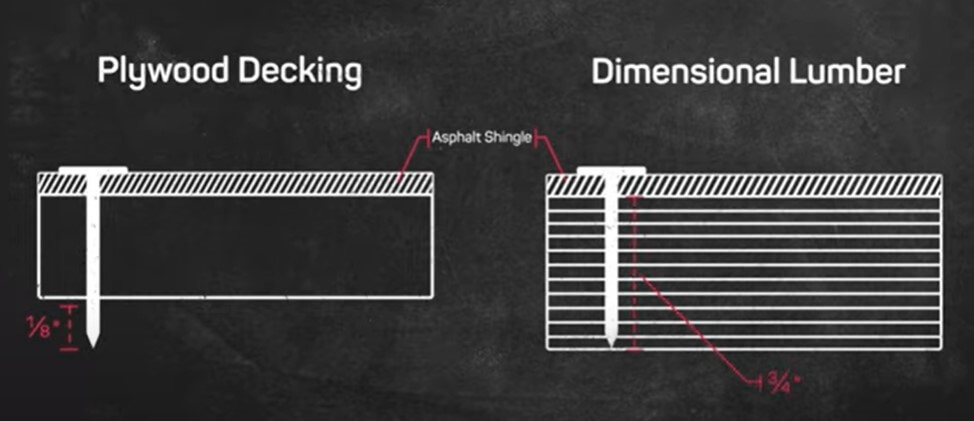
Adjust the Nail Gun Settings for Optimal Results:
Properly adjust the nail gun settings to achieve the correct nail depth and penetration. Adjust the pressure and speed settings based on the shingle material and manufacturer guidelines.
Test the nail gun on a scrap piece of shingle material to ensure the nails are being driven to the appropriate depth without overdriving or underdriving.
Techniques for Accurate and Consistent Nail Placement:
Maintain a consistent pattern and spacing for nail placement across the shingles. Typically, nails are placed near the edges and in the designated nailing zones of the shingle.
Use visual guidelines, such as alignment marks or chalk lines, to ensure accurate nail placement.
Maintain a steady hand and apply even pressure on the nail gun trigger to achieve consistent results.
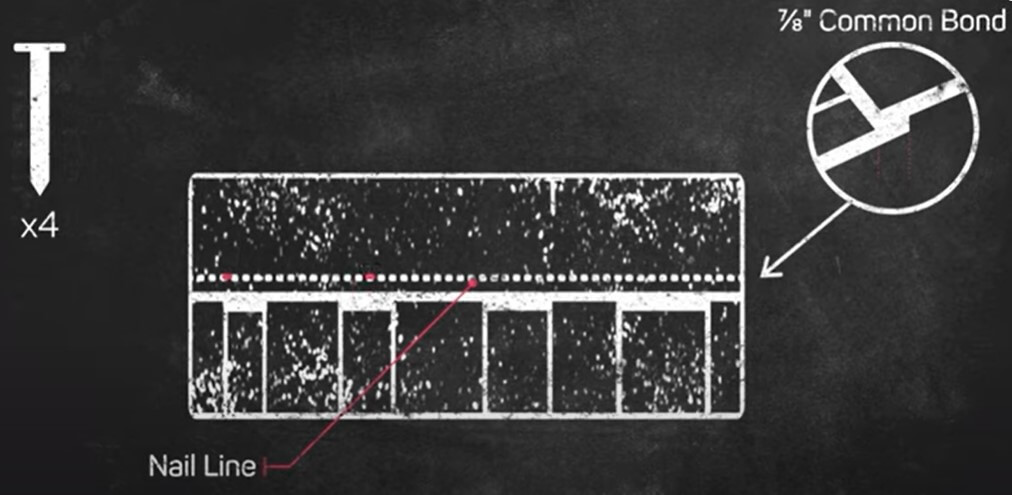
Follow Safety Precautions:
Always prioritize safety when using a nail gun. Wear appropriate personal protective equipment (PPE), including safety glasses, gloves, and hearing protection.
Familiarize yourself with the specific safety guidelines provided by the nail gun manufacturer.
Properly handle and store the nail gun when not in use, ensuring it is kept out of reach of unauthorized individuals.
Regularly Inspect and Maintain the Nail Gun:
Perform regular inspections of the nail gun to ensure it is in good working condition. Check for any signs of damage or wear, and promptly address any issues.
Follow the manufacturer’s recommended maintenance schedule, which may include lubricating the nail gun, cleaning out debris, and replacing worn parts as necessary.
By following these best practices, you can optimize the use of a nail gun for shingle installation.
Case Studies and Expert Opinions
A. Real-life experiences of professionals using nail guns for shingle installation
Case Study 1: Joe’s Roofing Company
Joe, a professional roofer, shares his experience using nail guns for shingle installation. He emphasizes the time-saving benefits of nail guns, allowing his team to complete roofing projects faster compared to hand-nailing.
Joe notes that nail guns provide consistent and accurate nail placement, resulting in a neater and more professional-looking installation. He mentions that with proper adjustment of nail gun settings, they have minimized the risks of overdriven or underdriven nails.
Overall, Joe finds that nail guns have significantly improved their efficiency and productivity, contributing to higher customer satisfaction.
Case Study 2: Sarah’s Roofing Services
Sarah, an experienced roofing contractor, shares her perspective on using nail guns for shingle installation. She emphasizes the reduced physical strain on her team when using nail guns, as it minimizes fatigue and repetitive motion injuries.
Sarah appreciates the speed at which nail guns can drive nails into shingles, allowing her team to complete projects within tight deadlines. However, she also highlights the importance of proper training and safety precautions to ensure accident-free usage.
Sarah concludes that nail guns have become an essential tool in her roofing business, enhancing both productivity and quality.
B. Insights from manufacturers and industry experts:
Expert Opinion 1: Mark Johnson, Roofing Manufacturer Representative
Mark Johnson, a representative from a leading roofing manufacturer, emphasizes the benefits of using nail guns for shingle installation. He explains that nail guns provide consistent and accurate nail placement, reducing the risk of leaks or shingle damage.
Mark advises contractors to choose nail guns that are specifically designed for roofing applications, as they have the necessary features and adjustments for optimal performance.
He recommends following manufacturer guidelines for nail length, gauge, and penetration depth to ensure proper attachment and warranty compliance.
Expert Opinion 2: Dr. Emily Thompson, Construction Industry Expert
Dr. Emily Thompson, a renowned expert in the construction industry, shares her insights on using nail guns for shingle installation. She highlights the increased efficiency and productivity offered by nail guns, as they save time compared to manual hand-nailing.
Dr. Thompson emphasizes the importance of selecting the right nail gun and adjusting the settings appropriately for the specific shingle material being installed. She encourages contractors to undergo proper training on nail gun usage and safety protocols to prevent accidents and ensure quality installations.
Dr. Thompson also suggests regular maintenance and inspection of nail guns to optimize their performance and longevity.
These case studies and expert opinions provide real-life experiences and insights from professionals and industry experts who have utilized nail guns for shingle installation. Their positive experiences highlight the benefits of using nail guns, including increased efficiency, accuracy, and reduced physical strain. Manufacturers and industry experts emphasize the importance of proper training, choosing the right nail gun, and following manufacturer guidelines for optimal results.
FAQs For Can You Use a Nail Gun For Shingles
Are nail guns suitable for all types of shingles?
Nail guns are suitable for most types of shingles, but it’s important to ensure compatibility with the specific shingle material being used.
What are the potential risks of using a nail gun for shingle installation?
Potential risks of using a nail gun include overdriven or underdriven nails, which can damage shingles, as well as the risk of accidents if not used properly.
How do I select the right nail gun for the specific shingle material I’m using?
To select the right nail gun, consider the shingle material and manufacturer recommendations for nail length, gauge, and angle.
Can nail guns cause damage to the shingles or underlying roof structures?
Improper use of a nail gun can potentially cause damage to shingles or underlying roof structures, emphasizing the need for proper adjustment and handling.
What safety precautions should be taken when using a nail gun for shingle installation?
Safety precautions when using a nail gun include wearing appropriate PPE, receiving proper training, and following manufacturer guidelines for safe operation and storage.
Conclusion
In conclusion, the use of nail guns for shingle installation offers numerous benefits and advantages.
Real-life experiences shared by professionals in the roofing industry demonstrate the time-saving efficiency and consistent nail placement provided by nail guns.
These experiences highlight the increased productivity, improved quality, and reduced physical strain associated with using nail guns.
Insights from manufacturers and industry experts further validate the positive impact of nail guns on shingle installation, emphasizing the importance of proper training, selecting the appropriate nail gun, and adhering to manufacturer guidelines.
By following best practices and considering the factors discussed, roofing professionals can harness the power of nail guns to achieve efficient, accurate, and aesthetically pleasing shingle installations that stand the test of time.
Additional Resources
A. List of recommended tools and equipment for shingle installation
When it comes to installing shingles, having the right tools and equipment is crucial to ensuring a successful project.
A list of recommended tools includes a hammer, roofing nails, a chalk line, a utility knife, a roofing shovel, a ladder, and safety equipment such as gloves and eye protection.
Additionally, an air compressor and nail gun can increase efficiency and save time.
It is important to choose high-quality tools and equipment to ensure safety and reduce the risk of damage to the shingles during installation.
Investing in the right tools from reputable brands will not only ensure a successful project but also save time and money in the long run.
B. Online tutorials and videos for using nail guns effectively
- Nailing Shingles Properly – How to Nail Roof Shingles – IKO
- ROOFER TRAINING | WHERE AND HOW TO INSTALL SHINGLES WITH A NAIL GUN
C. Relevant books, websites, and forums for further information
Books:
“Roofing Construction and Estimating” by Daniel Atcheson
“The Complete Guide to Roofing & Siding: Install, Finish, Repair, Maintain” by Creative Homeowner
Websites:
Roofing Contractor Magazine (www.roofingcontractor.com)
Asphalt Roofing Manufacturers Association (www.asphaltroofing.org)
Roofing Insights (www.roofinginsights.com)
Forums:
Roofing.com (www.roofing.com/forum)
ContractorTalk (www.contractortalk.com)
RoofingTalk (www.roofingtalk.com)
Reddit – r/Roofing (www.reddit.com/r/Roofing)
These resources provide valuable information, tips, and discussions on installing shingles with a nail gun.
They cover various topics related to roofing, including techniques, best practices, troubleshooting, and industry news.
Consulting these resources can further enhance your knowledge and understanding of using nail guns for shingle installation.
Recent Posts
Woodworking in 2025 is all about efficiency, precision, and smart technology. Whether you're a beginner or a seasoned craftsman, having the right tools can make all the difference. Here are the top 7...
Ever tried drilling into a piece of wood only to end up with a splintered mess or a wobbly hole? Yeah, it's more common than you think. Wood might seem like an easy material to work with, but...

